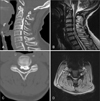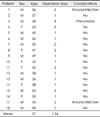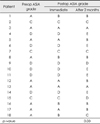Abstract
Objective
Open-door laminoplasty is an effective surgical technique in the treatment of multi-level cervical spondylotic myelopathy. In the present study, we reviewed the safety and short-term neurological outcome after open-door laminoplasty in the treatment of traumatic cervical cord injury.
Methods
We retrospectively reviewed our database over a 3-year period (January 2005-December 2007) and identified 18 surgically treated traumatic cervical spinal cord injuries without overt fracture or instability. All of these patients underwent open-door laminoplasty. Neurological function was assessed using the American Spinal Injury Association (ASIA) impairment scale. We collected data on the preoperative and the immediate postoperative and 2-month neurological examinations. We also reviewed the occurrence of complications and short-term radiological stability after the index procedure.
Results
There were 2 female and 16 male patients, with a mean age of 57.0(±6.0) years. All patients had hyperextension injuries with underlying cervical spondylosis, stenosis and ossification of posterior longitudinal ligament (OPLL) in the absence of overt fracture or instability. The average duration from injury to surgery was 1 day. The preoperative ASIA grade scale was grade A: 9 patients (50%), grade C: 3 patients (17%), and grade D: 6 patients (33%). There were no case of immediate postoperative deterioration or at 2 months follow-up. Neurological outcome (ASIA grade) of 13 patients (72.2%) were improved when examined 2 months after operation. We have no case of neurologic complication and radiological instability.
Figures and Tables
FIGURE 1
Preoperative radiologic finding. C-spine 3D CT sigittal view (A) shows ossification of posterior longitudinal ligament (OPLL) and narrowing of spinal canal. MR T2 sagittal image (B) shows intramedullary signal change after hyperextension injury. C-spine CT axail view (C) and C-spine MR axial view (D) show spinal canal narrowing.

References
1. Baba H, Furusawa N, Chen Q, Imura S. Cervical laminoplasty in patients with ossification of the posterior longitudinal ligaments. Paraplegia. 1995; 33:25–29.

2. Bosch A, Stauffer ES, Nickel VL. Incomplete traumatic quadriplegia. A ten-year review. JAMA. 1971; 216:473–478.

3. Bose B, Northrup BE, Osterholm JL, Cotler JM, DiTunno JF. Reanalysis of central cord injury management. Neurosurgery. 1984; 15:367–372.
4. Brodkey JS, Miller CF Jr, Harmody RM. The syndrome of acute central cervical spinal cord injury revisited. Surg Neurol. 1980; 14:251–257.
5. Chen LS, Blaw ME. Acute central cervical cord syndrome caused by minor trauma. J Pediatr. 1986; 108:96–97.

6. Chen TY, Dickman CA, Eleraky M, Sonntag VK. The role of decompression for acute incomplete cervical spinal cord injury in cervical spondylosis. Spine (Phila Pa 1976). 1998; 23:2398–2403.

7. Chen TY, Lee ST, Lui TN, Wong CW, Yeh YS, Tzaan WC, et al. Efficacy of surgical treatment in traumatic central cord syndrome. Surg Neurol. 1997; 48:435–440.

8. Guest J, Eleraky MA, Apostolides PJ, Dickman CA, Sonntag VK. Traumatic central cord syndrome: results of surgical management. J Neurosurg. 2002; 97:1 Suppl. 25–32.

9. Hirabayashi K, Satomi K. Operative procedure and results of expansive open-door laminoplasty. Spine (Phila Pa 1976). 1988; 13:870–876.

10. Hirabayashi K, Watanabe K, Wakano K, Suzuki N, Satomi K, Ishii Y. Expansive open-door laminoplasty for cervical spinal stenotic myelopathy. Spine (Phila Pa 1976). 1983; 8:693–699.

11. Koivikko MP, Myllynen P, Karjalainen M, Vornanen M, Santavirta S. Conservative and operative treatment in cervical burst fractures. Arch Orthop Trauma Surg. 2000; 120:448–451.

12. Papadopoulos SM, Selden NR, Quint DJ, Patel N, Gillespie B, Grube S. Immediate spinal cord decompression for cervical spinal cord injury: feasibility and outcome. J Trauma. 2002; 52:323–332.

13. Penrod LE, Hegde SK, Ditunno JF Jr. Age effect on prognosis for functional recovery in acute, traumatic central cord syndrome. Arch Phys Med Rehabil. 1990; 71:963–968.
14. Roselli R, Pompucci A, Formica F, Restuccia D, Di Lazzaro V, Valeriani M, et al. Open-door laminoplasty for cervical stenotic myelopathy: surgical technique and neurophysiological monitoring. J Neurosurg. 2000; 92:1 Suppl. 38–43.

15. Roth EJ, Lawler MH, Yarkony GM. Traumatic central cord syndrome: clinical features and functional outcomes. Arch Phys Med Rehabil. 1990; 71:18–23.
16. Schneider RC, Cherry G, Pantek H. The syndrome of acute central cervical spinal cord injury; with special reference to the mechanisms involved in hyperextension injuries of cervical spine. J Neurosurg. 1954; 11:546–577.




 PDF
PDF ePub
ePub Citation
Citation Print
Print






 XML Download
XML Download